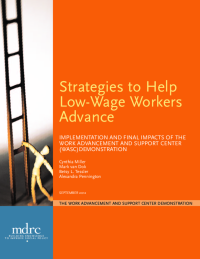Strategies to Help Low-Wage Workers Advance
Implementation and Final Impacts of the Work Advancement and Support Center (WASC) Demonstration
The Work Advancement and Support Center (WASC) demonstration was an innovative program designed to increase the incomes of low-wage workers. The program offered participating workers intensive employment retention and advancement services, including career coaching and access to skills training. It also offered them easier access to work supports, in an effort to increase their incomes in the short run and help stabilize their employment. Finally, both services were offered in one location — in existing One-Stop Career Centers created by the Workforce Investment Act (WIA) of 1998 — and by colocated teams of workforce and welfare staff. Services were provided to workers for two years between 2005 and 2010, and the program operated in three sites across the country: Bridgeport, Connecticut; Dayton, Ohio; and San Diego, California.
WASC was evaluated using a randomized control trial, in which individuals who were interested in and eligible for the program were assigned at random to either the WASC group, eligible to receive WASC benefits and services, or a control group, not eligible for WASC services but eligible to seek out existing services in the community. This is the final report in a series of reports prepared for the demonstration, and it covers the effects of WASC on workers’ benefit receipt and earnings for three to four years after study entry.
Key Findings
- The program increased workers’ receipt of work supports, although the effects varied substantially across the three sites. The largest effects were in San Diego, which had the lowest work support receipt rates at baseline. In that site in Year 2, for example, WASC increased food stamp receipt by 8 percentage points and child care subsidy receipt by 14 percentage points.
- The two programs that were able to offer participants eased access to funds for training — in Dayton and Bridgeport — substantially increased workers’ participation in education and training activities and their receipt of certificates and licenses. In Bridgeport, for example, WASC increased participation in education and training by 16 percentage points.
- The same two programs that increased participation in education and training also increased earnings in Year 3. In Dayton, individuals in the WASC group earned $1,152 (or 8 percent) more than those in the control group. However, the effects in Dayton had faded somewhat by Year 4.
The findings provide a number of lessons for WIA and for advancement policies more generally. In particular, increased access to training for low-income workers like these appears to be a critical part of any advancement strategy. Yet the earnings gains associated with participation in training may be short-lived if participants are not given more guidance about the right types of training to pursue or opportunities for additional training.






